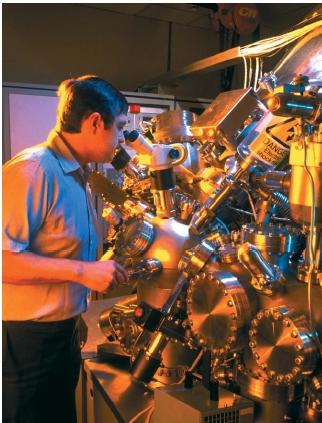Quantitative analysis
The term quantitative analysis is used to described any procedure by which the percentage composition of any compound or mixture is determined. For example, chemists might want to know the exact composition of some new compound that has been discovered. Or they might want to find out what the percentage of gold is in a new ore that has been discovered. Both of these questions can be answered by the procedures of quantitative analysis. Quantitative techniques can be divided into two general categories: wet or classical techniques and instrumental methods.
Classical methods
Classical methods have been used since the beginning of modern chemistry in the nineteenth century. They generally make use of balances and calibrated glass containers to measure the percentage composition of a compound or mixture. For example, the procedure known as gravimetric analysis involves the addition of some chemical to the unknown compound or mixture to produce a precipitate. A precipitate is a solid formed during a chemical reaction—usually in water—that eventually settles out of the solution. In a gravimetric analysis, the precipitate is filtered, washed, dried, and weighed. The composition of the original unknown can then be calculated from the weights of the precipitate and sample and original unknown.
Words to Know
Classical (or wet) analysis: Those procedures in which a suitable chemical reagent is reacted with some unknown, either by precipitate formation or titration.
Gravimetric analysis: A classical quantitative technique in which a chemical added to an unknown forms an insoluble precipitate with some part of the unknown. The precipitate is then collected and weighed.
Instrumental analysis: Any quantitative technique in which some property of the unknown material (electrical, optical, thermal, etc.) is measured and related to the amount of the unknown present.
Volumetric analysis: A classical quantitative technique in which a solution of known concentration is reacted exactly with an unknown and a calculation is performed to find the amount of the unknown present.
Another classical form of quantitative analysis is known as volumetric analysis. Volumetric analysis uses a procedure known as titration, in which a solution whose concentration is known precisely is caused to react with an unknown sample. The amount of the known solution needed to react precisely with the sample of the unknown can be used to calculate the percentage composition of the unknown.
Instrumental methods
Suppose that you shine a beam of X rays at a sample of gold metal. Those X rays will cause electrons in gold atoms to become excited and give off light. The same result can be produced with any one of the 100 or so chemical elements. The only difference is that the electrons of each

element respond differently to the beam of X rays. This means that a chemist can decide which element or elements are present in a substance by shining X rays on the substance and observing the light pattern that is produced.
Forms of energy other than X rays can be used to produce the same results. For example, different elements conduct an electric current more or less effectively. In some cases, the presence of various elements in an unknown sample can be discovered, then, simply by passing an electric current through the sample and measuring the electrical conductivity in the sample.
Instrumental techniques have made possible a much greater sensitivity in the analysis of unknown materials. In most classical forms of analysis, an accuracy of about one part per thousand is not unusual (meaning one milligram of some substance is detectable in a one-gram sample).
Instrumental techniques have the capability to detect concentrations of one part per million, one part per billion, and, in the very best cases, one part per trillion. At that level of sensitivity, it would be possible to detect a grain of sand in an volume of water equal to about three typical high school swimming pools.
[ See also Spectroscopy ]